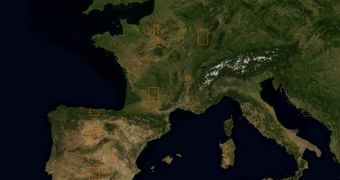Bing Maps is continually evolving thanks to an ambitious endeavor from Microsoft designed to provide an unmatched user experience for its mapping platform through consistent and current high-resolution imagery.
The Bing Maps Global Ortho imagery program has been in full swing for over a year now, since spring 2010, resulting in imagery updates involving 30cm (1 foot) aerial blanket coverage. Although the Bing Maps Global Ortho imagery program is currently focused on the continental United States and Western Europe, the software giant insists that it’s designed to eventually cover the entire world.
With the Bing Maps World Tour application, Microsoft is providing users with shortcuts to access the latest Bing Maps imagery refresh, part of the Bing Maps GeoArt collection of content.
“The Bing Imagery Technologies team (BITs), located in Boulder, Colorado, has spent more than a year collecting the new Bing Maps imagery, and has been quietly publishing this aerial imagery to the Bing Maps web site,” revealed Jerry Skaw, from the Bing Maps team.
“The first of it began appearing in August 2010 and to date, 46% of the project has been captured and roughly 349 blocks equaling 2,771,192 sq kilometers from 37 States, France and Spain have been published, plotted in the below maps.
“The project is scheduled for completion by June 2012 at which point a refresh cycle will begin to update much of what will already have been collected, with priority placed on locations that have been more subject to change (as opposed to, say, the Mojave Dessert).”
Users that will take advantage of the World Tour app to witness first-hand the evolution of Bing Maps will be able to enjoy high-resolution imagery from no less than 153 locations.
According to the Redmond company, Microsoft partners used the UltraCamG digital aerial camera available from Microsoft’s Photogrammetry Division, formerly Vexcel Imaging.
“The storing and processing of this imagery requires a significant amount of computing power. The BITs data compute site provided by DELL has a huge amount of container-based compute and storage power to be able to automate a lot of the things would normally be done manually: currently in excess of 16,500 compute cores and roughly 55 petabytes of storage,” Skaw added.
“Yet this facility runs off hydroelectric power and between this and the DELL design that features evaporative cooling, it is highly-efficient from a power usage effectiveness (PUE) perspective ( 1.03 ).”

 14 DAY TRIAL //
14 DAY TRIAL //